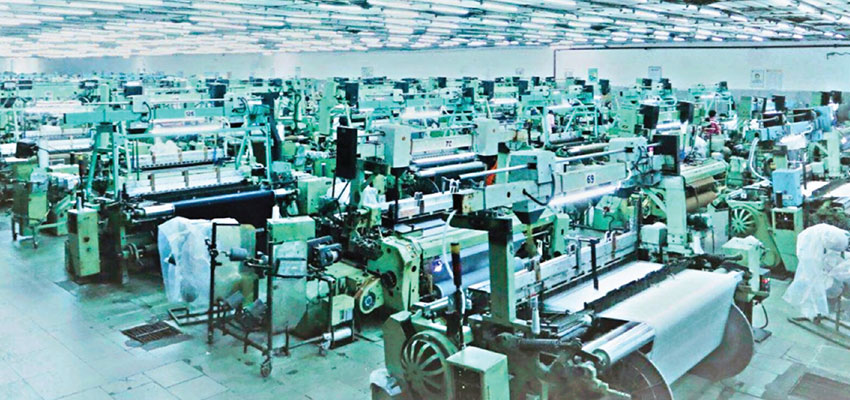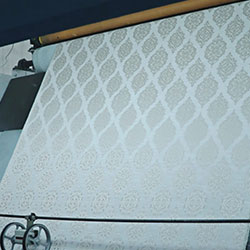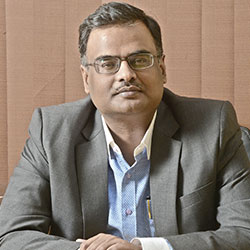Sustaining Business Legacy

The now familiar story of textile doyens, the late P N Churiwal and LN Jhunjhunwala, in building a legacy brand BSL Limited (formerly Bhilwara Synthetic Limited), almost dates back to the 1930s, when the duo was classmates at Kolkata’s bustling Burrabazar’s Maheswari Vidyalaya School. With the advent of the polyester fabric market, their friendship transitioned to that of business partners in 1971. Envisaging a demand for polyester suiting, they ventured into fabric weaving from synthetic yarn and pioneered the poly viscose suits concept, laying the foundation for BSL in Bhilwara, the 'textile city' in Rajasthan, which transformed the textile industry. Subsequently, the group underwent transitions and built a conglomerate across diverse sectors. The BSL Group is currently steered by Late Churiwals’s son, Arun Churiwal, as Chairperson and grandson Nivedan Churiwal as the Managing Director. In an exclusive interview with Corporate Citizen, Nivedan Churiwal shares the legacy, transformations, and strategy that has sustained BSL to stay afloat despite the flux in the apparel or fabric market
Nivedan has been actively involved with the family business since his college days and would visit Bhilwara, in the Mewar region of Rajasthan, for training at the company’s manufacturing plant. "My late Grandfather, P.N. Churiwal, held a special place in my life and I cherish the invaluable lessons learned from him, in life and business. He instilled an unwavering belief that hard work has no substitute, and by consistently doing the right things, success will inevitably follow. This principle has shaped my personal and professional endeavours, serving as a constant reminder of the importance of perseverance and integrity,” said Nivedan Churiwal, Managing Director, BSL Ltd.
After his graduation, he shifted base to Bhilwara for around two years and devoted his time to the factory and immersed himself in learning about the company’s operations. He eventually built his acumen with the changing times, ushering in new furnishing business ventures, and testing waters for functional fabrics, including its partnership with IKEA.
Building a Heritage
"Consumers are becoming more conscious of their environmental footprint, and the textile industry needs to adapt accordingly. I anticipate a greater demand for sustainable materials, such as organic cotton, recycled fibres, and innovative eco-friendly textiles. The shift in consumer preferences aligns with the global trend toward sustainable and responsible fashion"
-Nivedan Churiwal
Corporate Citizen: What according to you is BSL’s legacy?
Nivedan Churiwal: BSL Ltd.’s deep-rooted history in the textile sector has been developed over several decades. It began as a weaving unit for the sole purpose of producing synthetic fabrics, with a pilot facility that housed eight shuttle looms. Over time, the company expanded into a diversified enterprise, offering a wide range of products, including synthetic, worsted, and cotton yarns, synthetic and worsted suiting, and furnishing fabrics. As a prominent player in the textile business, we have a history of adopting innovation and using cutting-edge technologies. By employing cutting-edge materials, innovative manufacturing processes, and sustainable business practices, the company strives to stay ahead of the curve. Customer loyalty over the years has strengthened the brand's market position and its subsequent expansion into new markets.
CC: When did you get initiated into the business?

Given my family’s background in the textile sector, I was constantly exposed to discussions and information about the textile industry. However, my involvement began after completing my 12th grade when I embarked on my initial trips to Bhilwara. Throughout my college years, I visited Bhilwara multiple times, underwent fundamental training in various manufacturing processes and familiarised myself with the company's marketing setup. After my graduation, I shifted base to Bhilwara for some two years, gaining in-depth learning of the company’s operations. I also embarked on marketing trips to various regions countrywide and overseas markets. These experiences helped acquire a comprehensive understanding of the industry and laid the groundwork for my future involvement with the company. I subsequently expanded my horizons to various other aspects of the business.
CC: What was your very first responsibility with the company?
I took charge as the Executive Director, marking my initial position of responsibility in 1997-1998. I was engaged briefly in outsourcing and merchant export activities, eventually venturing into the furnishing business in the early 2000s. Since then, I embarked on a gradual journey across departments, expanding my scope and accountability. Over time, my growth progressed parallelly with that of the company’s steady growth.
CC: What is your primary role with BSL?
In the early 2000s, I was engaged with outsourcing and merchant export activities for a brief period before venturing into the furnishing business. The move became a stepping-stone in my career trajectory and personal growth story.
CC: How did you impact the company's transitions?
I became the Managing Director in 2021 and have since implemented several strategic changes. It included cost reduction, streamlining manpower, enhancing production efficiencies, diversifying our product offerings, expanding our dealer networks across India, and exploring opportunities for increased retail presence. It is the culmination of these collective efforts and strategic moves that have been propelling the company's growth in recent years.
Textile Transitions
"I believe that the company has played a significant role in introducing and enabling innovations that have revitalised India’s textile sector. Some key innovations we believe to have championed include sustainable practices, advanced technology integration, and consistent product innovations"
CC: Is poly-viscose suiting your USP?
BSL is one of the most diversified textile companies in India, with a wide-ranging product portfolio. In the suiting segment, we have successfully established a pan-India presence, serving domestic markets. The export division operates in approximately 50- 60 countries, catering to a global clientele. The production capabilities of the company’s yarn business encompass synthetic, vertex, and polyester yarn. We have recently expanded into the manufacturing of 100% cotton yarn. Diversification caters to a wide range of customer preferences and market demands. Our product range and global presence in the suiting and furnishing vertical, and expansion capabilities across the yarn sector have strengthened our ground in the industry.
CC: Has BSL’s innovations restored the lost glory of India’s textile sector?
I believe that the company has played a significant role in introducing and enabling innovations that have revitalised India’s textile sector. Some key innovations we believe to have championed include sustainable practices, advanced technology integration, and consistent product innovations.
CC: What innovative strategies did you deploy?

Our sustainable practices entails using recycled raw materials, reducing water consumption, and adopting renewable energy sources. We have invested in state-of-the-art machinery, automation, and digitisation to optimise production, reduce waste, and ensure product consistency. We have leveraged technology in establishing productivity and competitiveness as per industry standards. Our product innovations have consistently focused on meeting evolving customer demands.
We have introduced new fabrics with enhanced performance features, such as moisture-wicking, antimicrobial properties, and sustainable materials. Our research and development efforts have led to the creation of novel textile solutions that have transformed the market landscape.
CC: How have you leveraged the various product/manufacturing verticals?
The company’s various products and manufacturing verticals have played crucial roles in the company's growth. Our suiting product exports account for around 30-35% of our total turnover, followed by the furnishing segment, contributing approximately 20%, and 25% of revenue is generated from our yarn business. We anticipate significant changes in the percentages due to the expansion of our cotton-spinning operations. It is expected to drive substantial growth in the yarn segment, altering the revenue distribution within our product verticals. Off course, to maximise profitable growth areas, it is important to consider market conditions, customer demands, and production efficiencies. While each vertical contributes to our overall success, the profitability of specific areas may fluctuate over time.
CC: How effective has R&D been for the company’s growth?
R&D has significantly contributed to our sustained success as we have consistently strived to stay ahead of market trends and customer preferences. It has allowed us to develop new products, improve existing offerings, and embrace advanced manufacturing techniques. By investing in R&D, we have been able to introduce innovative textiles, enhance product performance, and address evolving sustainability concerns. We have managed to stay afloat through a combination of factors which includes a customer-centric approach, operational excellence, strategic partnerships, and financial stability.
CC: Which factors have sustained the company in its journey?
While research and development (R&D) have played a significant role in the company’s sustained success, another important aspect has been in collaborating with strategic partners. We have formed alliances with renowned designers, global brands, and industry experts, which has enabled us to gain access to new markets, expanded our reach, and leveraged collective expertise in driving growth. We have been optimising our production processes, improving efficiency, and controlling costs. By continuously enhancing our operational capabilities, we have been able to adapt to market dynamics, meet changing demands, and ensure sustainable profitability. Our prudent financial management practices, disciplined budgeting, and efficient resource allocation have helped us weather economic fluctuations, maintaining stability in a volatile market.
CC: What guides your strategic leadership and vision for the company?

I work closely with our management team to set clear goals, define strategies, and chart a path for growth. It involves identifying new market opportunities, diversifying our product range, and expanding our customer base. I have encouraged a culture of innovation within the organisation, encouraging creative thinking, collaboration, and experimentation, which has helped develop cutting-edge textiles and stay at the forefront of industry trends. Our R&D efforts have focused on enhancing product performance, exploring sustainable materials, and leveraging advanced manufacturing processes. I have recognised the importance of nurturing strong relationships with our customers, suppliers, and partners. By understanding their needs, fostering trust, and delivering value, we have built long- lasting partnerships that have contributed to our growth. Customer satisfaction has been a key priority, and we have continuously strived to exceed their expectations through superior products and exceptional service.
CC: Which other functional aspects have enhanced operational efficiencies?
An aspect has been in implementing efficient operational practices via process optimisation, streamlining workflows, and embracing technology for improved efficiency and productivity. Maximising operational excellence has enabled us to respond quickly to market demands, reduce costs, and enhance overall performance. Financial management has been a key focus area. I have encouraged prudent budgeting, effective cost management, and strategic investments. A strong financial foundation, has helped weather economic fluctuations and seize growth opportunities. It is the combination of these factors that has propelled our company's growth and enabled us to thrive in the dynamic textile industry.
CC: How did you manoeuvre strategy in the past 5-10 years?
The past 5-10 years were challenging for our company as the textile sector faced difficulties, resulting in stagnant growth in our top and bottom line. We diversified our focus and dedicated efforts to all segments of our business, and experienced growth across the board. Our suiting exports, domestic exports, and yarn divisions have all demonstrated positive results. The comprehensive growth approach has been a driving force behind our recent successes. I firmly believe that it is essential for all verticals to grow hand-in-hand, despite their varied growth trajectories. We have maintained a balanced focus on all aspects of our operations, helping us to navigate challenges and capitalise on opportunities across the textile sector. Moving forward, we hope to foster growth across all verticals, leveraging our expertise, market insights, and strategic partnerships. Our commitment to holistic development remains steady, as we understand that the collective progress of all segments is vital for continued growth and prosperity.
CC: What other principles kept the company afloat when several household textile brands ceased to exist in the past decade?
In a volatile and ever-changing business landscape, the combination of keeping our feet- on-the-ground, and our unwavering financial principles have helped drive our company forward. It has instilled confidence among stakeholders, including customers, investors, and employees, and helped us weather uncertainties and capitalise on emerging opportunities. Our commitment to financial discipline, complements our other organisational, functional, and market-driven factors, which has been a key force in thriving and growing in a dynamic market environment. We have remained steadfast in our commitment to maintaining financial stability and sustainability, which will continue to propel us towards a successful future.
CC: What has been the turning point in the company’s current growth?
The introduction of the furnishing business and the partnership with IKEA marked a turning point for us. We recognised the need to foster growth across multiple verticals simultaneously, and as a result, we witnessed a resurgence in our overall performance. We are one of IKEA’s exclusive suppliers, and our premium furnishing and fabric products are available across 450+ IKEA stores worldwide. The partnership is our commitment to delivering high-quality and distinct offerings in the furnishing industry.
IKEA Connect
CC: What was the idea behind the IKEA collaboration?
The collaboration with IKEA was initiated through an unexpected encounter in 2011, and the partnership was established around 2011-12. Initially, the Swedish company approached us for yarns, but during discussions, they expressed their need for fabric manufacturers. The chance meeting presented a great opportunity to explore a potential partnership. We recognised the potential benefits of working with IKEA and engaged in further discussions. We were inspired by IKEA's global reputation for quality and innovation in the furniture industry and saw the collaboration as a strategic move to expand our business and enhancing our global presence.
CC: What were the strong synergies anticipated with the IKEA partnership?

Several triggers helped forge the vendor- based relationship with IKEA. Our expertise in textile manufacturing and ability to deliver high-quality products aligned with IKEA's requirements. Additionally, our commitment to sustainability and ethical practices resonated with IKEA's values, which played a crucial role in establishing a strong rapport between our companies. Our willingness to adapt catered to IKEA's specific needs, including customised fabric solutions and adherence to their stringent quality standards, which bridged the partnership. The synergy between our respective strengths and the shared vision of delivering exceptional products fuelled our collaboration. While the initial interaction was initiated by IKEA's interest in our yarns, the subsequent partnership was the result of both parties recognising the potential for a mutually beneficial relationship.
CC: How has the IKEA arrangement benefitted the company?
We are one of their key vendors and exclusive furniture fabric suppliers to IKEA worldwide including Southeast Asia. The meeting opened doors to a long-standing vendor- based relationship. It has provided us with an opportunity to showcase our capabilities as a reliable supplier and gain access to a vast global market through their extensive network. Since then, our collaboration has flourished, driven by mutual trust, shared values, and a commitment to delivering innovative and sustainable fabric solutions.
CC: Did the pandemic impact the collaboration?
In recent years, we have faced certain challenges and disruptions, including the impact of Covid-19, which have affected the growth of our IKEA business. However, as we move past the pandemic challenges, we are optimistic about the future. We have been witnessing increased business opportunities with them, particularly in India, driven by the implementation of the China One Plus strategy. With the strategic approach and favourable market conditions, we are confident that the expansion of the IKEA business will lead to overall revenue growth for the company.
CC: How do you match IKEA’s sustainable compliances?
The collaboration with IKEA has brought immense credibility to our company, as it has some of the most stringent and challenging sustainable norms worldwide. Over the past decade, we have thrived for 100% norm compliance as per their standards. We understand the importance of meeting deadlines and ensuring that our products reach their stores and customers as scheduled. We have gained IKEA’s trust based on our reliability, and on-time delivery. The norms entail rigorous operational processes and practices, implementing eco-friendly and resource-efficient manufacturing techniques, emphasising the use of sustainable materials, and prioritising ethical labour practices.
Fact File
CC: What is the domestic textile market worth in revenue terms?
The Indian domestic textile and apparel industry contributed around 2.3% to the country’s overall GDP and was valued at around 5.30 trillion in 2020. The demand is expected to increase at a CAGR of 20.56% reaching INR 13.50 trillion by 2025.
CC: What futuristic changes do you anticipate in the domestic market?
I believe there will be an increased focus on sustainability and eco-friendly practices. Consumers are becoming more conscious of their environmental footprint, and the textile industry needs to adapt accordingly. I anticipate a greater demand for sustainable materials, such as organic cotton, recycled fibres, and innovative eco-friendly textiles. The shift in consumer preferences aligns with the global trend towards sustainable and responsible fashion. I foresee the government implementing policies that would cater to domestic manufacturing, incentivise investments in technology and machinery, and facilitate ease of doing business. Government initiatives like the "Make in India" campaign and the National Textile Policy are already in place, and I expect further reforms to create a conducive environment for the textile industry to thrive.
CC: What other incentives would help uplift the domestic textile market?
Budgetary initiatives could play a significant role in supporting the sector's growth. Increased allocation of funds for research and development, skill development programmes, infrastructure development, and export promotion could bolster the competitiveness of the Indian textile industry. Targeted financial support schemes, including interest subsidies and tax incentives, would encourage investment and innovation within the sector. Overall, I am optimistic about the future of the domestic textile market in India. With an increased emphasis on sustainability, favourable government policies, and targeted budgetary initiatives, the sector has the potential to witness robust growth. Budgetary provisions that focus on infrastructure development, including logistics and connectivity, could facilitate a smoother supply chain operation. It would reduce transportation costs, improve delivery timelines, and enhance the overall efficiency of the sector.
CC: What about automation incentives for the sector?
We are committed to staying abreast of new changes, embracing innovation, and leveraging opportunities for sustainable growth in the evolving business landscape. Additionally, government policies that incentivise investments in technology and machinery could enhance the efficiency and productivity of textile manufacturers. Subsidies or tax incentives for adopting advanced manufacturing technologies, automation, and digitalisation can enable textile companies to improve their operational processes, reduce costs, and enhance their competitiveness in the market.
CC: How has your product portfolio fared in the export market?
Exports play a significant role in our overall turnover with approximately 60-65% of our total turnover from exports. Our new cotton spinning venture, currently under process, primarily focuses on exports within the same segment. We expect our export business to be maintained at 60 to 70% of our total turnover, which indicates our strong position in international markets and our commitment to delivering quality products in the global market.
Work-Life Balance
Our sustainable practices entails implementing recycled raw materials, reducing water consumption, and adopting renewable energy sources
CC: How have you matched your professional goals with that of the company’s growth?
It is essential for me to align my aspirations and efforts directly to the overall success and development of the company. I constantly evaluate the company's strategic goals and objectives, work closely with the executive team to understand the long-term vision, and identify key growth areas. I stay informed about market trends, customer needs, and industry advancements, which effectively shapes my professional goals in line with that of the company's growth.
CC: How do you de-stress from your work schedules?
As the Managing Director of a company, de- stressing from work schedules is crucial for maintaining a healthy work-life balance and ensuring personal well-being. Maintaining a strong support network is equally vital. I spend quality time with my family and friends, engaging in meaningful conversations and shared activities. It helps me disconnect from work, creating a sense of balance in my life. Incorporating mindfulness techniques and meditation into my daily routine helps me to reduce stress and cultivate a calm mindset. Taking a few minutes each day to focus on my breath and be present at the moment allows me to regain perspective and manage stress effectively.
CC: Have your children or the next generation in the family shown interest in joining the group?
As a family, we emphasise the importance of individual growth and personal aspirations. We have encouraged the next generation to pursue their passions and interests outside of the family business, providing them with the freedom to choose their career paths. We have created an open and supportive environment that encourages family members to explore their interests and potential roles within the company. We provide them with exposure to different aspects of the business, allowing them to gain valuable insights and experiences.
CC: What is your advice to the next generation in steering the company’s legacy?
While we support and encourage the next generation's interest in joining the company, we also ensure that they undergo a thorough and structured process of learning and development. This includes mentorship programs, on-the-job training, and exposure to different departments and functions within the organisation. They need to gain diverse experiences and expertise before considering a formal role within the company. By doing so, they can bring fresh perspectives, new ideas, and unique skill sets to the table.